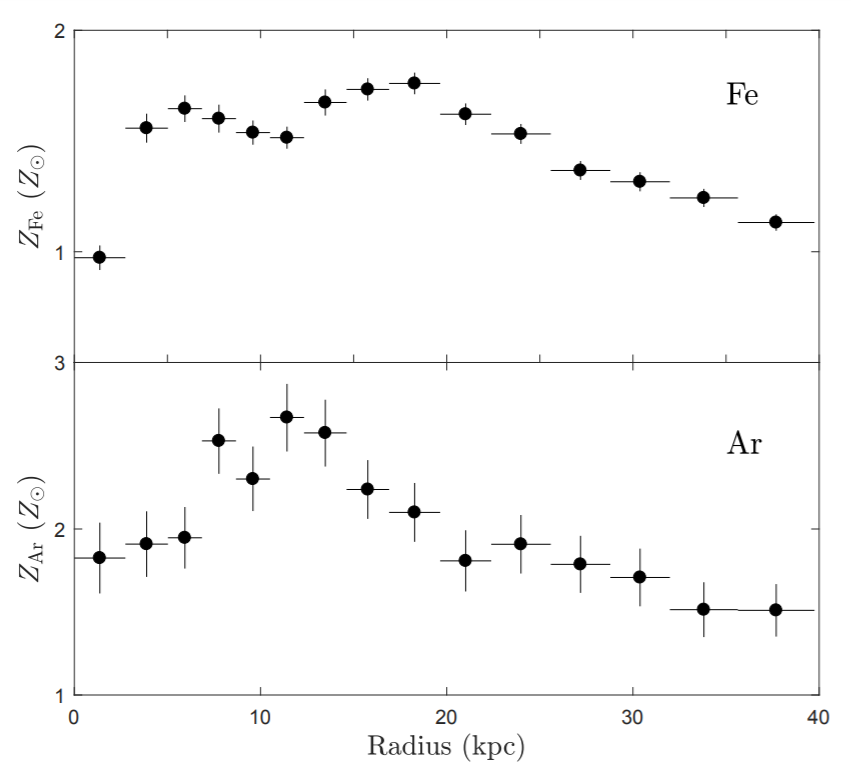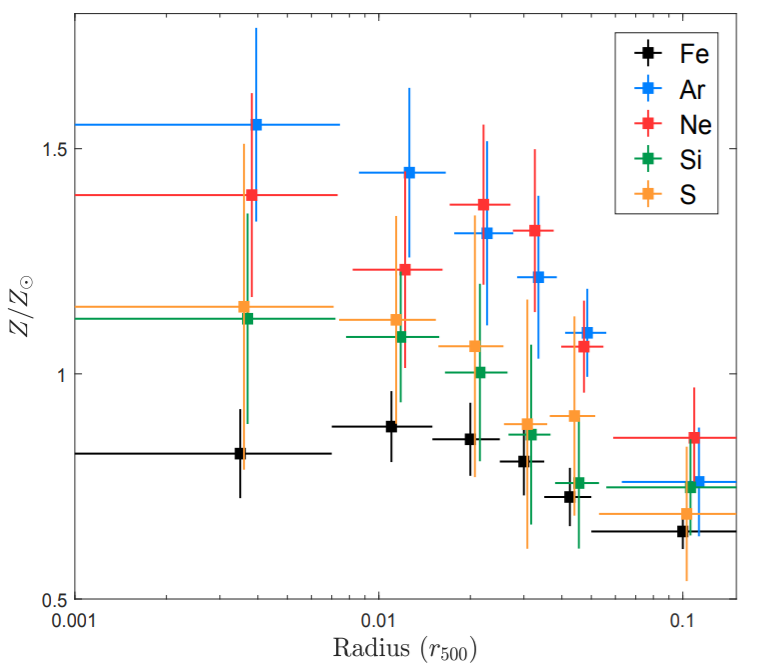Where is the missing Iron in the intracluster medium of large galaxy clusters?
Galaxy clusters have the bulk of their baryonic mass distributed in a hot and diffuse X-ray emitting gas, the intracluster medium (ICM), while only a minority is locked up into stars. The ICM is made out of hydrogen and helium, and a few percent of heavy elements that are produced by massive stars and eventually ejected into the diffuse gas. Studying the abundances of these heavy elements is an effective way to trace the history of the ICM. In the central region of clusters, complex interactions are going on between the ICM, the active galactic nucleus (AGN) hosted by the brightest cluster galaxy (BCG) and the other member galaxies with their intergalactic medium (IGM). Although the growing amount of data from optical, infrared, sub-mm and X-ray spectroscopy help in tracing gas in different phases, a coherent picture is still lacking. A fundamental question is how all these processes affect the cycle of baryons in various phases and lead to the enrichment of the ICM.
Thanks to X-ray spectroscopy, which is key to trace several elements, the distribution of Iron in the ICM is observed in every cluster and group of galaxies. Iron abundance is measured to increase significantly in the central regions, just where the BCG is located, and where the ICM density also increases. However, an unexpected feature has been recently observed: a small-scale (of the order of 10 kpc) Iron decrement (called here “Iron-drop”) at the center of the abundance peak in a few clusters. It has been proposed that this Iron drop may be due, at least partially, to the depletion of reactive elements (like Iron, but also other elements like Silicon and Sulphur) into dust grains in the central, high-density regions. According to this scenario, noble gas elements are not expected to be depleted into dust, and therefore their distribution should follow the general increase of metal abundance toward the center. This dust-depletion mechanism can therefore be directly tested by comparing the radial abundance profiles of Iron to that of noble gas elements such as Argon and Neon, which are detectable in high S/N X-ray spectra of the ICM.
 |
Figure 1. The abundance profiles of Iron (upper panel) and Argon (lower panel) of the Centaurus cluster. The abundances are in units of solar values. Significant central drops of both iron and argon can be seen clearly in the profiles. |
The recent work of Ang Liu, Ph.D student at the Arcetri Astrophysical Observatory, collaborating with, among others, Paolo Tozzi at Arcetri, aims at exploiting the angular resolution of Chandra data to measure the abundance profiles of Argon and possibly of Neon, in a sample of twelve groups and clusters where a central Iron-drop has been previously detected, and compare them to the profiles of Iron and other reactive elements, including Silicon and Sulphur. The authors find that also Argon and Neon drop in most of the sources (one example, the profiles of the Centaurus cluster are shown in Figure 1). This result is consistent with an abundance drop common to the three elements, which suggests a mechanical process removing the highly enriched ICM from the innermost region, rather than the depletion onto dust grains, as an explanation for the observed profiles. However, by combining the profiles of Iron, Argon, Neon, Silicon, and Sulphur of all the clusters in the sample, the authors have been able to clearly observe that the depth of the drop is different for different elements, pointing to some other mechanism at play. Liu and collaborators found that Argon (and possibly Neon) has a still larger abundance in the center with respect to Iron, Silicon and Sulphur, while they tend to be consistent in the outer regions (see Figure 2). In other words, Argon shows a much steeper gradient than Iron, Silicon, and Sulphur. This suggests that a differential removal mechanism is at play, and this may well be the mentioned dust-depletion of the reactive elements into dust grains present in the BCG.
 |
Figure 2. The average abundance profiles of Iron, Argon, Neon, Silicon, and Sulphur, as a function of the rescaled radius r/r500 for all the clusters in the sample. The data points have been slightly shifted on the x-axis for clarity. |
In summary, this work confirms a scenario in which some fraction of Iron is depleted into dust grains in the inner regions of these clusters, although the global central abundance drop is mostly due to mechanical processes, like the displacement of metal-rich ICM from the very center to larger radii by AGN-driven feedback. The detection of dust depletion effect on ICM chemical composition provides a new approach to study the interaction and transition of the ICM and IGM in the core of galaxy clusters.
The results of this work are published in: “On the origin of central abundance drops in the ICM of galaxy groups and clusters”, Ang Liu, Meng Zhai, and Paolo Tozzi, MNRAS, in press, and can also be accessed here
Edited by A. Liu, P. Tozzi, A. Gallazzi



